Messier Monday: The farthest Messier object (for now), M58
A big, bright, dust-rich barred spiral galaxy that won’t stay this way for long!
“When we are sure that we are on the right road there is no need to plan our journey too far ahead. No need to burden ourselves with doubts and fears as to the obstacles that may bar our progress. We cannot take more than one step at a time.” –Orison Swett Marden
Welcome back to another Messier Monday, where we take an in-depth look at a new one of the 110 deep-sky wonders that make up the Messier catalogue. All throughout the next few months, the Virgo Cluster looms prominently in the early night sky, and it contains more Messier objects clustered together than any other region of the celestial heavens.
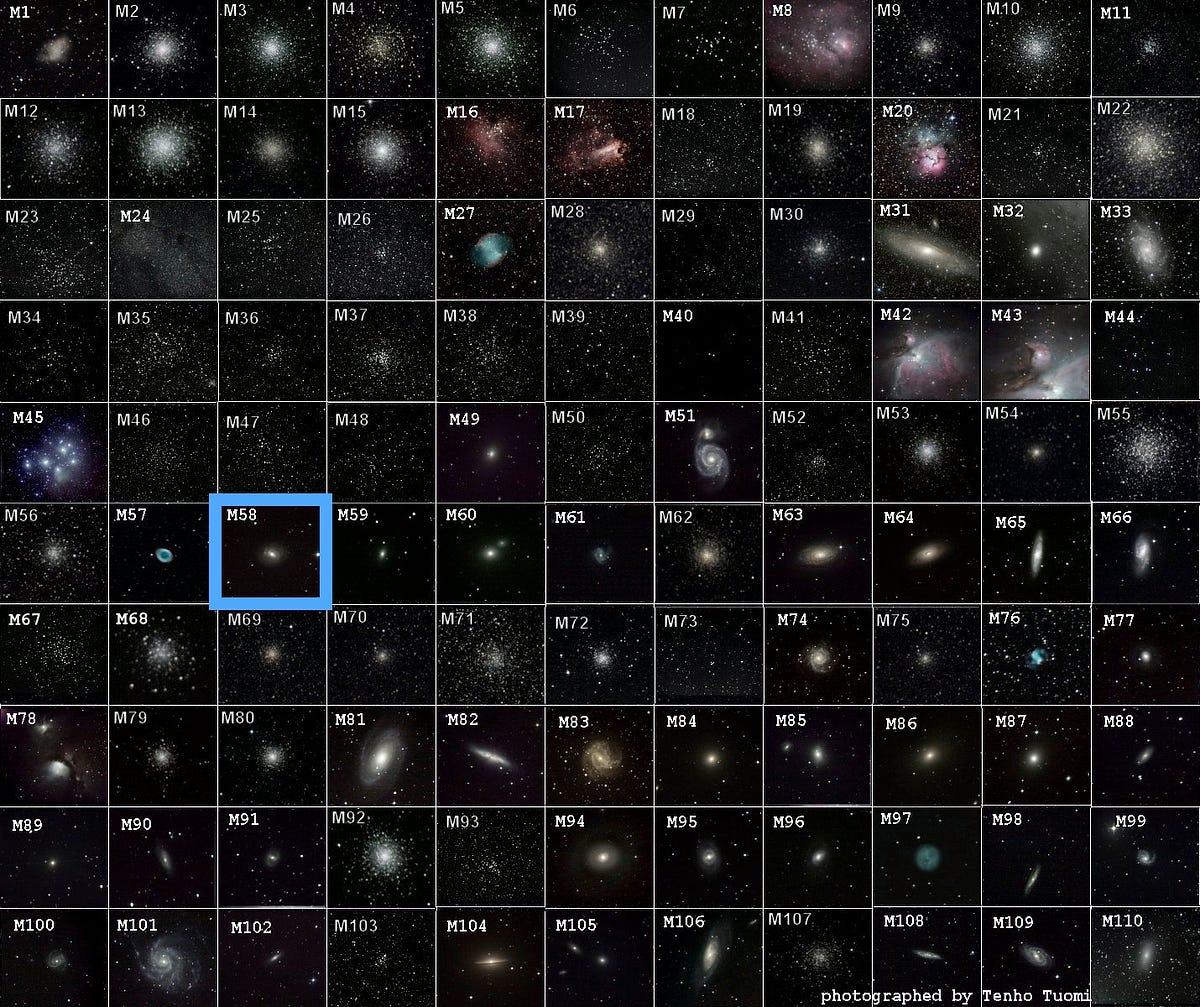
In the innermost region of Virgo — and, indeed, of practically all large clusters of galaxies — ellipticals predominate, having arisen from major mergers of previous generations of large galaxies. But on the outskirts, spirals are just as common (if not moreso) as their gas-poor counterparts. For today, let’s take a look at one of the more unusual member of this cluster: a barred spiral galaxy close to the cluster’s core, Messier 58!
Here’s how to locate it.
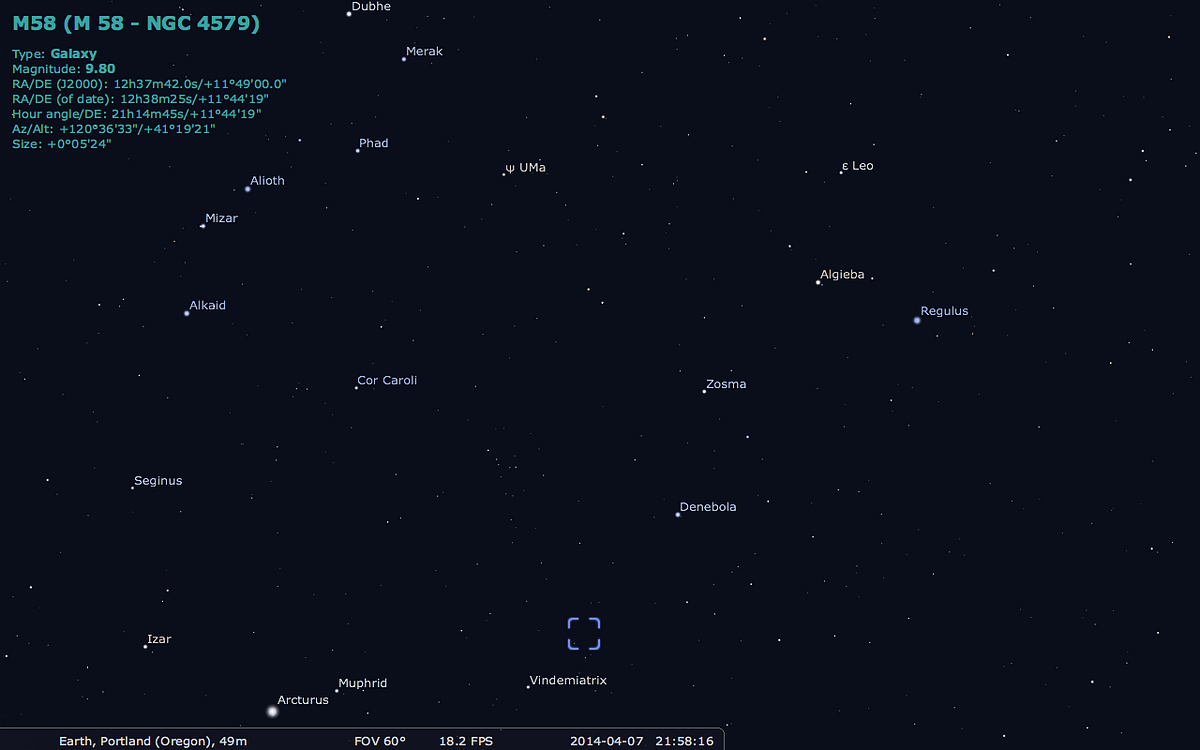
The key to finding any of the Virgo galaxies is knowing where to begin in the sky. You can always get there from the handle of the Big Dipper; navigate “downwards” from the tip of the dipper’s handle (Alkaid) towards the prominent Cor Caroli and then continue on to Denebola, the second brightest star in the constellation of Leo. The brightest star in Leo is Regulus, but if you move in the opposite direction from Denebola, you’ll come to Vindemiatrix instead, an easy naked-eye star.
And it’s between Denebola and Vindemiatrix that you can guide yourself to the Virgo cluster.
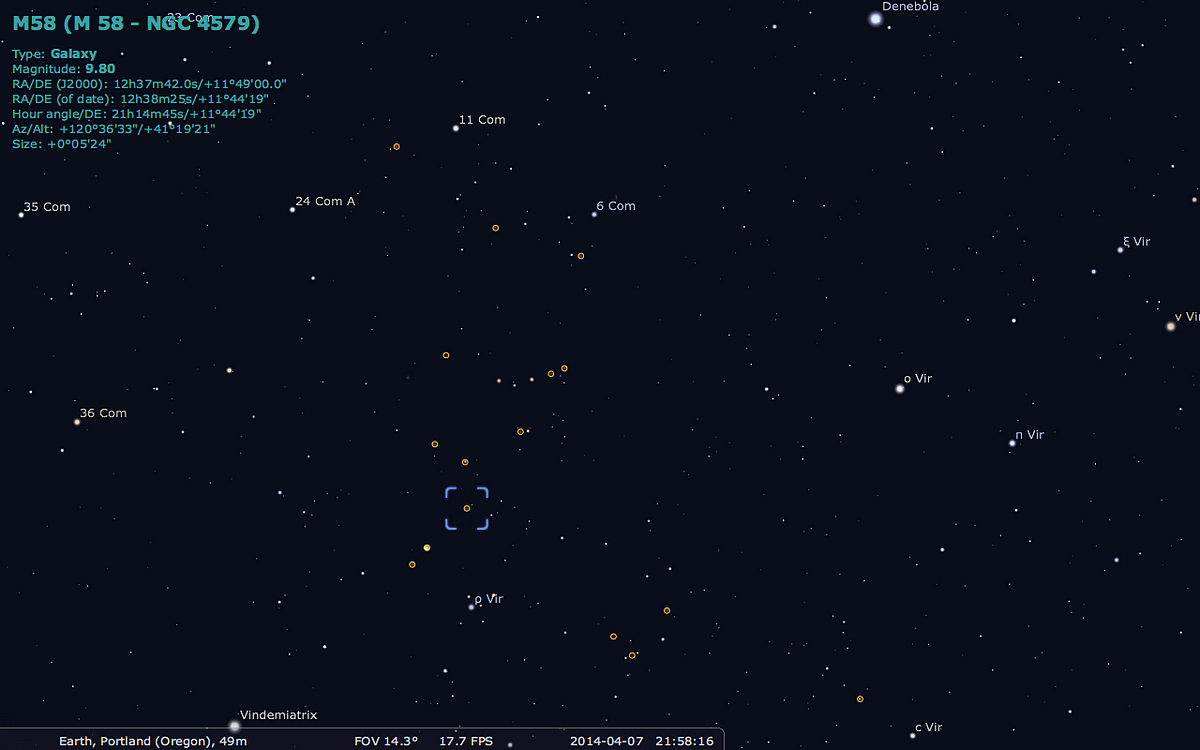
In between them are four faint (but still naked-eye) stars in the shape of a kite or cross, with ρ Virginis the one located closest to Vindemiatrix. The little orange circles, above, show the positions of a number of prominent Virgo galaxies, with the most central region of the cluster located about midway between ρ Virginis and 6 Comae Berenices.
But Messier 58 is located very close to ρ Virginis, just about 2 degrees away.
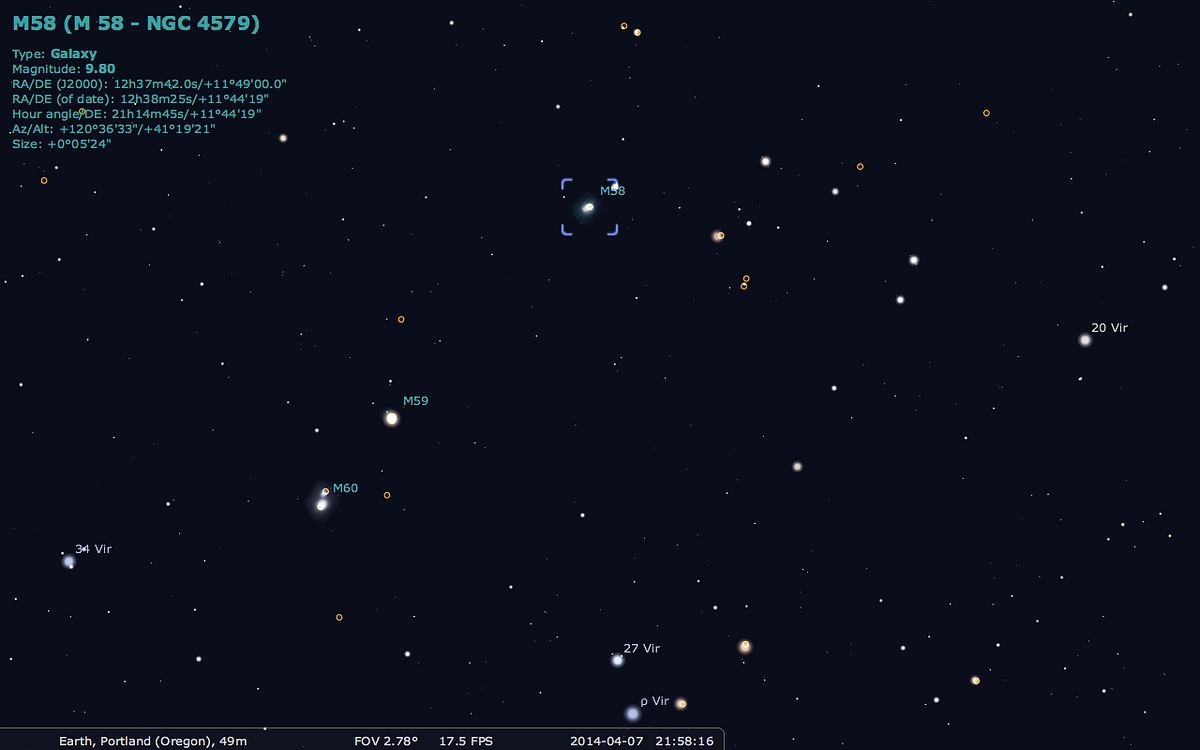
If you’re looking with a wide-field view, you likely won’t see anything very impressive, as it — along with most Virgo galaxies — will simply appear as a faint, cloud-like star with extended brightness fading away towards the edges.
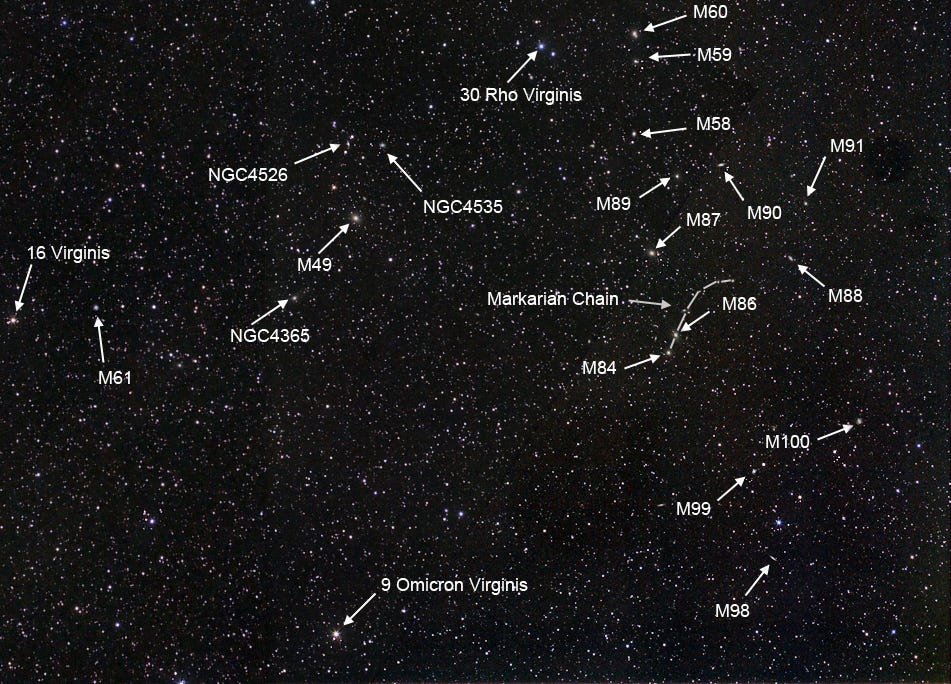
You might remember (from last week) that Messier 87 is the central giant of the Virgo Cluster, the largest single galaxy within 100 million light-years of us. But although Messier objects M58, M59 and M60 appear to make a line moving away from M87, the others are all ellipticals; only M58 is a spiral.
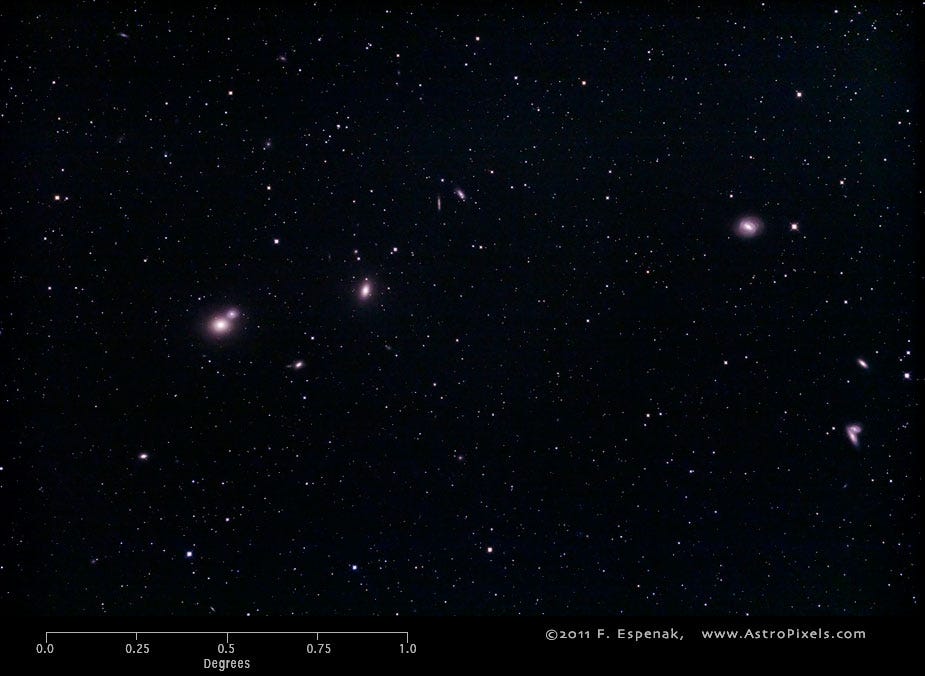
But in truth, Messier 58 is a remarkable object in its own right: it’s more than just a spiral galaxy, it’s one of only four barred spiral galaxies in the entire Messier catalogue! Its central region is quite bright, and in even small telescopes (4″, or 10 cm), you can see that it’s brighter in one direction than the other.
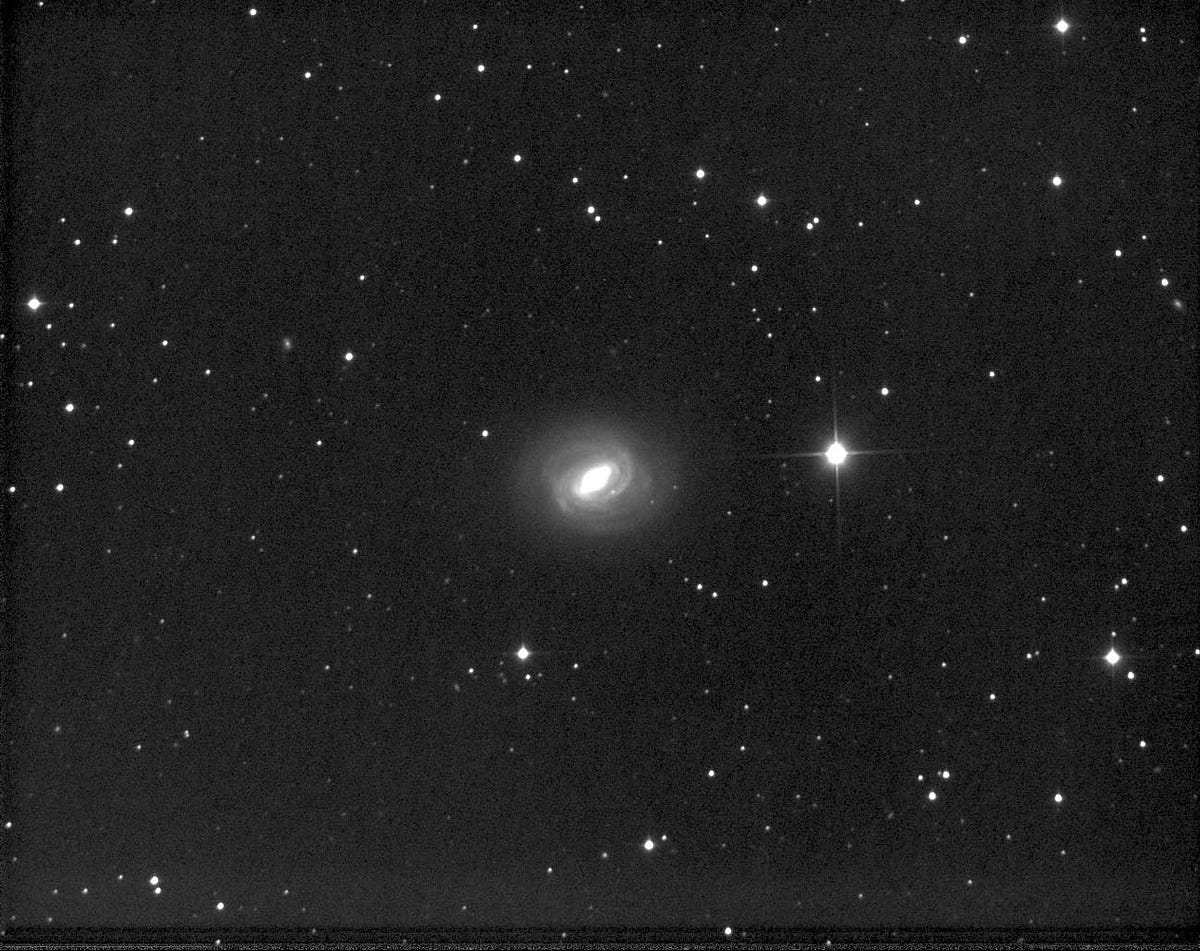
And while the Virgo cluster boasts a number of bright galaxies, including 15 Messier objects, it’s a very large structure in reality, located 54 million light-years distant but extending outwards an additional 7-to-10 million light-years in all directions.
It just so happens that Messier 58 is located on the opposite side of the Virgo cluster to us, making it — to the best of our knowledge — the single most distant object in the entire Messier catalogue.
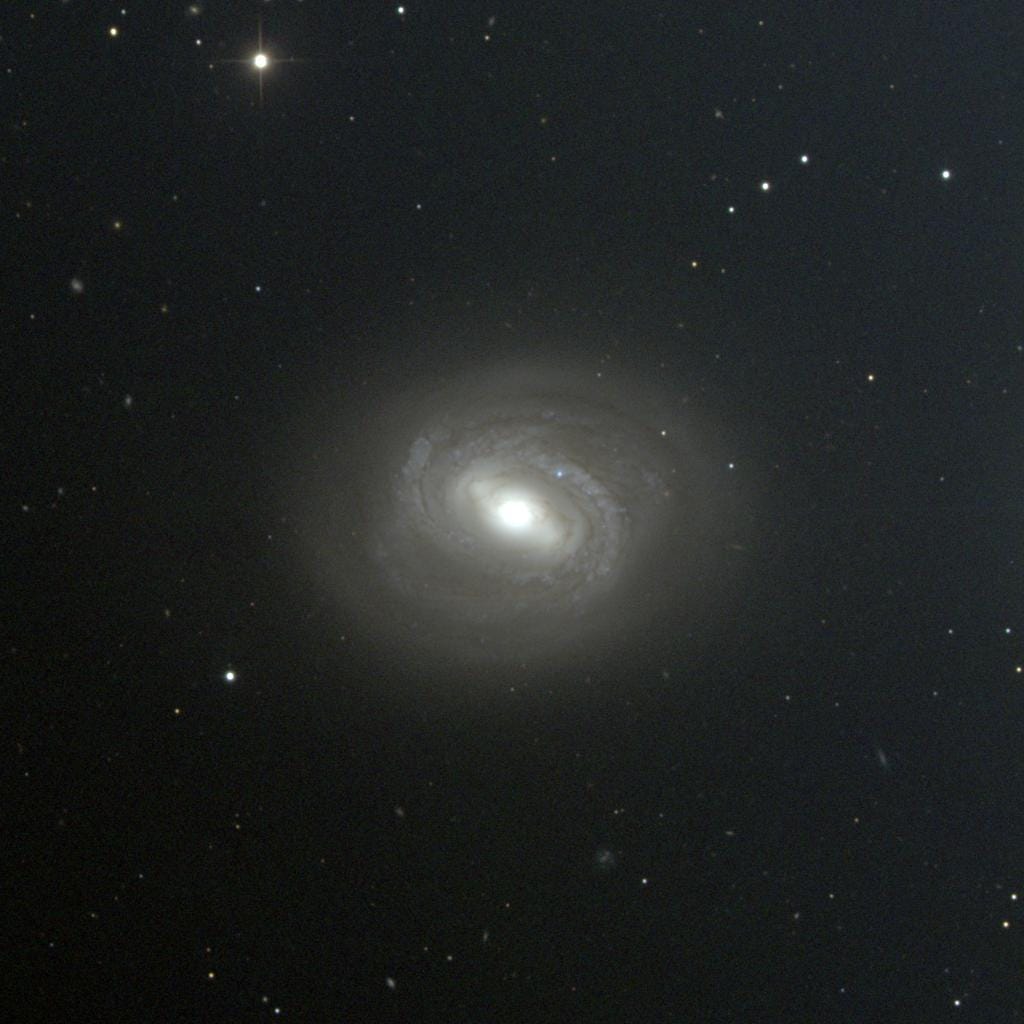
It also happens that this galaxy is going to remain that way for a little while longer; it’s still moving away from the center of Virgo at a few hundred km/s, and will probably head out an additional million light-years or two before turning around and plunging back in towards the center. And our view of it right now can tell us an awful lot about it.
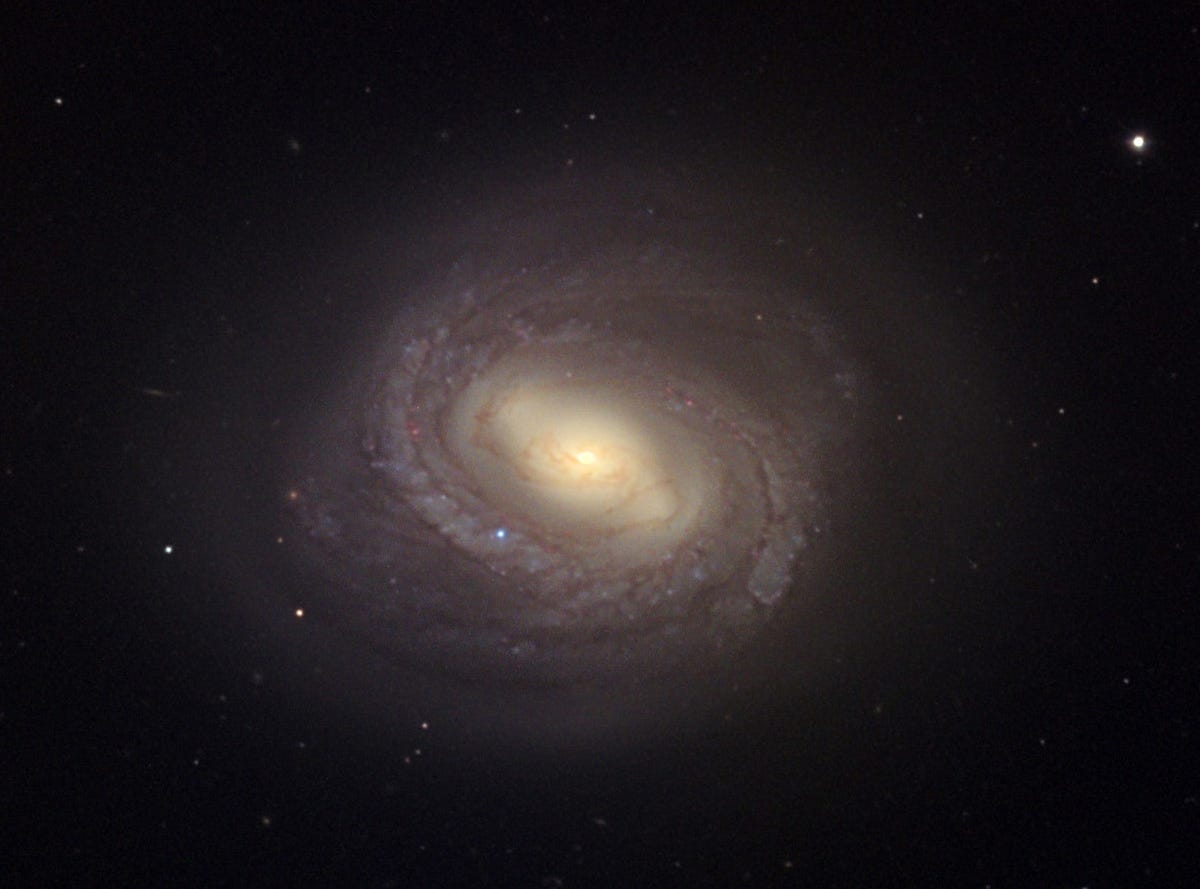
For one, see those few faint pink regions lining its spiral arms? Those are regions of star formation, nebulae not so different from our nearby Orion Nebula. But what’s interesting about Messier 58 is that — for a spiral galaxy — it’s actually quite poor in gas, most likely because its trips through the intergalactic medium in Virgo has stripped most of it away. All that likely remains is the gas present in the disk of the galaxy itself.

The prominent bar is a feature that appears in about a third of spiral galaxies; our own Milky Way has a relatively modest one. It funnels gas in towards the center, and in the case of Messier 58, a black hole of about 70 million solar masses (some 18 times the mass of our own galaxy’s) awaits it. At the very center, the galaxy is presently active (albeit at a low level), and is one of only a handful of galaxies known to contain a small ring of newborn stars around the galactic core. (As the narrow-band ultraviolet Hubble image, below, discovered just a few years ago!)
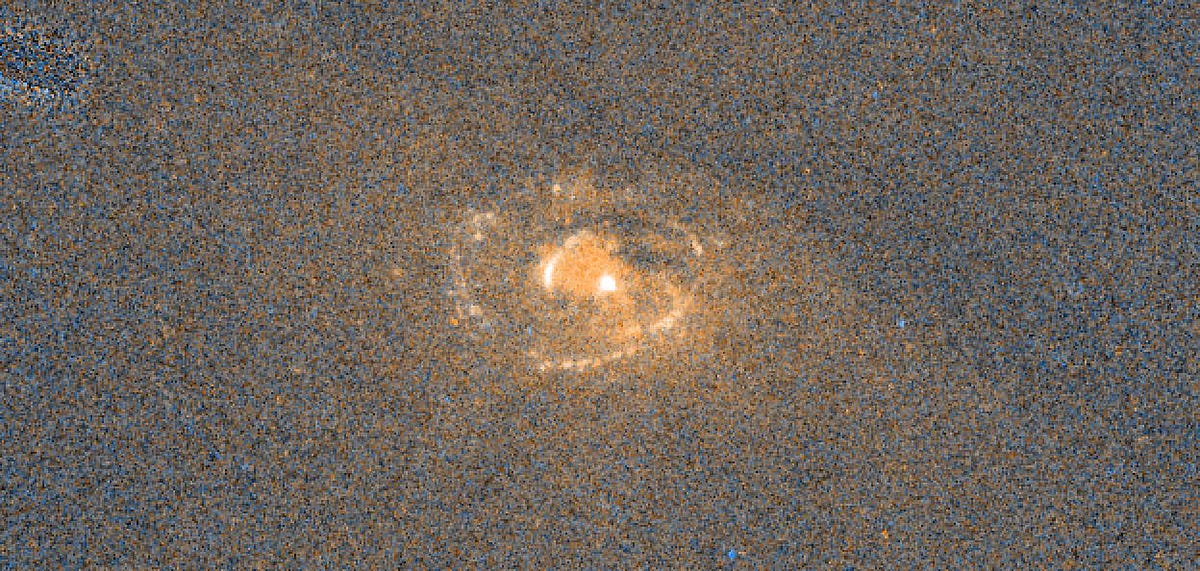
This last feature is particularly interesting, because the entire region interior to the spiral arms is otherwise made out of an older population of stars, with no younger stars in there. This infrared multiwavelength composite image from the Spitzer Space Telescope show the vast differences in stellar populations between the arms (in red) and the inner region (in blue).
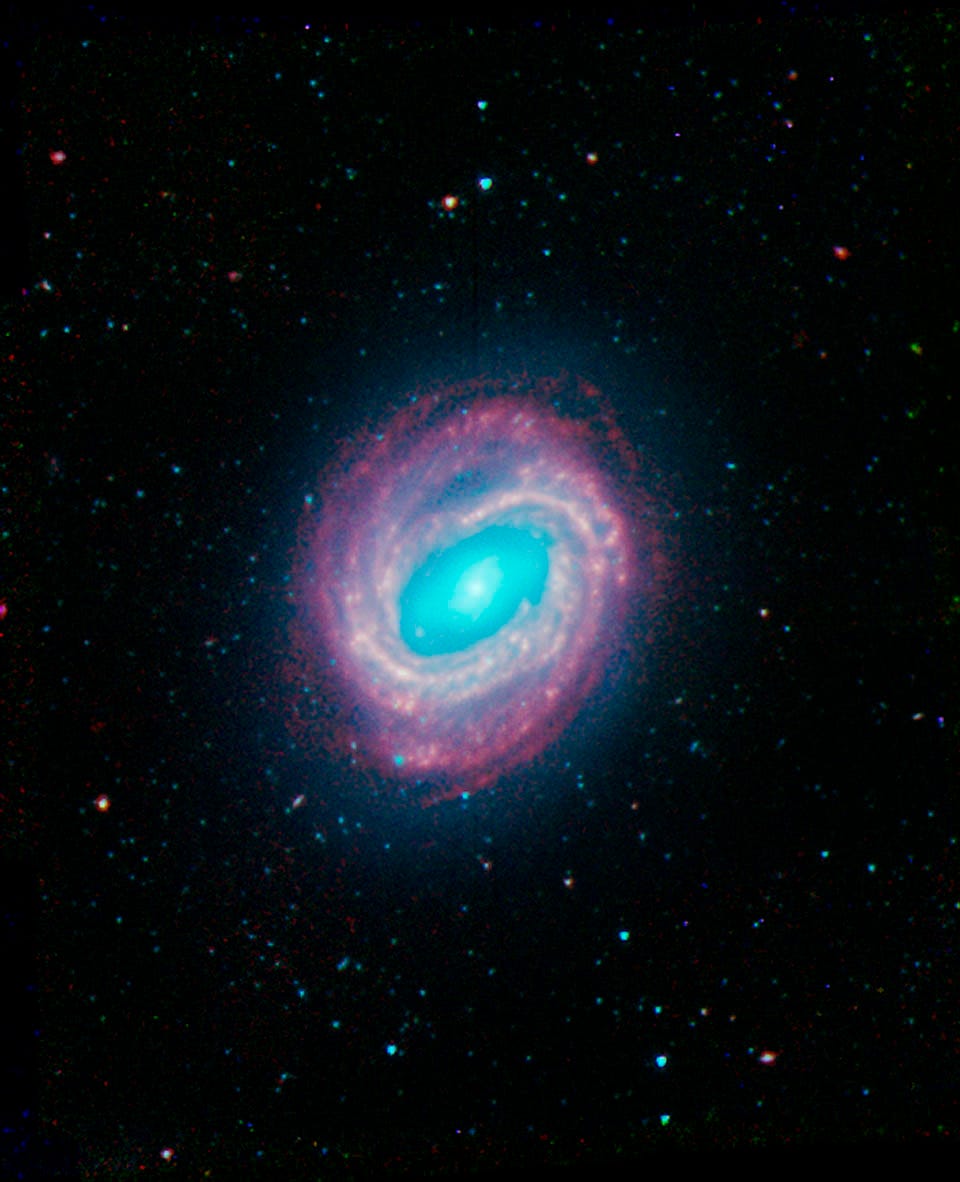
There are so many delightful ways to look at and admire this glorious sight of nature, but my favorite view — for once — doesn’t come from Hubble, but rather from Adam Block, whose M58 portrait I’ve cropped and enlarged for you below. You can see the light-blocking dust grains trace out a spiral all the way from the center, something the stars don’t do themselves!
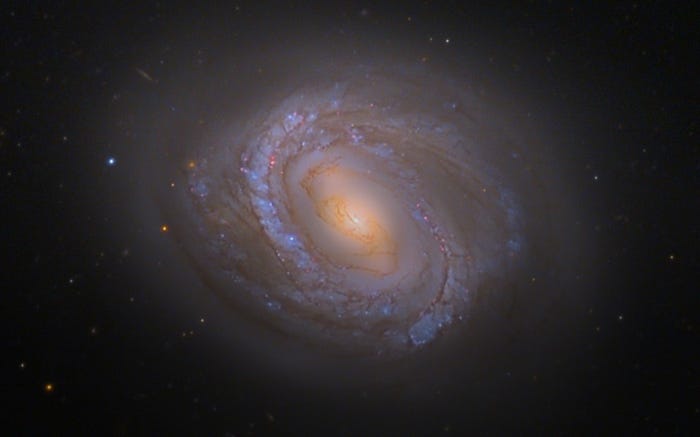
Image credit: Adam Block / Caelum Observatory / Mt. Lemmon SkyCenter / University of Arizona, via http://www.caelumobservatory.com/gallery/m58.shtml.
In a few billion years, Messier 58 will likely merge with another large galaxy in this cluster, losing its spiral structure entirely and becoming a giant elliptical. Eventually, like every galaxy in this cluster, it will merge with the central behemoth in Virgo, as eventually it will all just become one supergiant elliptical. Until then — for at least billions of years — enjoy the sights of this brilliant barred spiral!
And that’s the cosmic story of the most distant object in the entire Messier catalogue! Have a look back at all our previous Messier Mondays:
- M1, The Crab Nebula: October 22, 2012
- M2, Messier’s First Globular Cluster: June 17, 2013
- M3, Messier’s First Original Discovery: February 17, 2014
- M5, A Hyper-Smooth Globular Cluster: May 20, 2013
- M7, The Most Southerly Messier Object: July 8, 2013
- M8, The Lagoon Nebula: November 5, 2012
- M11, The Wild Duck Cluster: September 9, 2013
- M12, The Top-Heavy Gumball Globular: August 26, 2013
- M13, The Great Globular Cluster in Hercules: December 31, 2012
- M15, An Ancient Globular Cluster: November 12, 2012
- M18, A Well-Hidden, Young Star Cluster: August 5, 2013
- M20, The Youngest Star-Forming Region, The Trifid Nebula: May 6, 2013
- M21, A Baby Open Cluster in the Galactic Plane: June 24, 2013
- M25, A Dusty Open Cluster for Everyone: April 8, 2013
- M29, A Young Open Cluster in the Summer Triangle: June 3, 2013
- M30, A Straggling Globular Cluster: November 26, 2012
- M31, Andromeda, the Object that Opened Up the Universe: September 2, 2013
- M32, The Smallest Messier Galaxy: November 4, 2013
- M33, The Triangulum Galaxy: February 25, 2013
- M34, A Bright, Close Delight of the Winter Skies: October 14, 2013
- M36, A High-Flying Cluster in the Winter Skies: November 18, 2013
- M37, A Rich Open Star Cluster: December 3, 2012
- M38, A Real-Life Pi-in-the-Sky Cluster: April 29, 2013
- M39, The Closest Messier Original: November 11, 2013
- M40, Messier’s Greatest Mistake: April 1, 2013
- M41, The Dog Star’s Secret Neighbor: January 7, 2013
- M42, The Great Orion Nebula: February 3, 2014
- M44, The Beehive Cluster / Praesepe: December 24, 2012
- M45, The Pleiades: October 29, 2012
- M46, The ‘Little Sister’ Cluster: December 23, 2013
- M47, A Big, Blue, Bright Baby Cluster: December 16, 2013
- M48, A Lost-and-Found Star Cluster: February 11, 2013
- M49, Virgo’s Brightest Galaxy: March 3, 2014
- M50, Brilliant Stars for a Winter’s Night: December 2, 2013
- M51, The Whirlpool Galaxy: April 15th, 2013
- M52, A Star Cluster on the Bubble: March 4, 2013
- M53, The Most Northern Galactic Globular: February 18, 2013
- M56, The Methuselah of Messier Objects: August 12, 2013
- M57, The Ring Nebula: July 1, 2013
- M58, The Farthest Messier Object (for now): April 7, 2014
- M60, The Gateway Galaxy to Virgo: February 4, 2013
- M63, The Sunflower Galaxy: January 6, 2014
- M64, The Black Eye Galaxy: February 24, 2014
- M65, The First Messier Supernova of 2013: March 25, 2013
- M66, The King of the Leo Triplet: January 27, 2014
- M67, Messier’s Oldest Open Cluster: January 14, 2013
- M68, The Wrong-Way Globular Cluster: March 17, 2014
- M71, A Very Unusual Globular Cluster: July 15, 2013
- M72, A Diffuse, Distant Globular at the End-of-the-Marathon: March 18, 2013
- M73, A Four-Star Controversy Resolved: October 21, 2013
- M74, The Phantom Galaxy at the Beginning-of-the-Marathon: March 11, 2013
- M75, The Most Concentrated Messier Globular: September 23, 2013
- M77, A Secretly Active Spiral Galaxy: October 7, 2013
- M78, A Reflection Nebula: December 10, 2012
- M79, A Cluster Beyond Our Galaxy: November 25, 2013
- M81, Bode’s Galaxy: November 19, 2012
- M82, The Cigar Galaxy: May 13, 2013
- M83, The Southern Pinwheel Galaxy, January 21, 2013
- M85, The Most Northern Member of the Virgo Cluster, February 10, 2014
- M86, The Most Blueshifted Messier Object, June 10, 2013
- M87, The Biggest One of them All, March 31, 2014
- M88, A Perfectly Calm Spiral in a Gravitational Storm, March 24, 2014
- M92, The Second Greatest Globular in Hercules, April 22, 2013
- M93, Messier’s Last Original Open Cluster, January 13, 2014
- M94, A double-ringed mystery galaxy, August 19, 2013
- M95, A Barred Spiral Eye Gazing At Us, January 20, 2014
- M96, A Galactic Highlight to Ring in the New Year, December 30, 2013
- M97, The Owl Nebula, January 28, 2013
- M98, A Spiral Sliver Headed Our Way, March 10, 2014
- M99, The Great Pinwheel of Virgo, July 29, 2013
- M101, The Pinwheel Galaxy, October 28, 2013
- M102, A Great Galactic Controversy: December 17, 2012
- M103, The Last ‘Original’ Object: September 16, 2013
- M104, The Sombrero Galaxy: May 27, 2013
- M106, A Spiral with an Active Black Hole: December 9, 2013
- M108, A Galactic Sliver in the Big Dipper: July 22, 2013
- M109, The Farthest Messier Spiral: September 30, 2013
And come back next time for another one; we’ve got the whole rest of the year before we get to the end!
Have your say at the Starts With A Bang forum on Scienceblogs!





